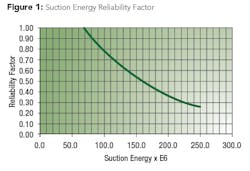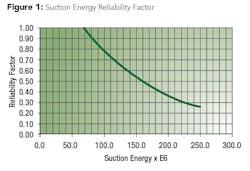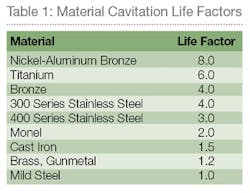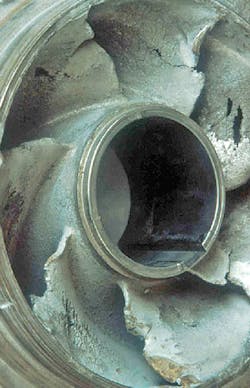When Is It Wise to Pay More for Your New Pump?
By Allan R. Budris
The purchase price of pumping equipment is typically less than 15 percent of the total ownership cost. In fact, unscheduled maintenance is often the most significant expense of pump ownership, and users who buy pumps mainly based on the lowest initial cost often end up with higher overall life cycle costs due to higher unscheduled maintenance. Initial cost is also influenced by such critical factors as the size and design of the pump and piping, pump speed, the quality and/or duty rating of the equipment being selected, materials of construction and control method. All of these choices can substantially affect the life cycle cost and working life of the pump.
Field Example
I was recently contacted to investigate premature pump failures, which were largely due to the contractor opting for the lowest cost impeller, wear ring and mechanical seal face materials (cast iron) in a cooling water application, in addition to applying unfilled expansion joints on the pump suction flange. To make matters worse, the contractor also chose to select higher speed (lower cost) pumps, which resulted in them having High Suction Energy. Fig. 1 shows the general impact of suction energy on reliability.
The result of these initial cost savings was severe premature corrosion and cavitation damage (see Fig. 2), which will cost the contractor over $100,000 per pump in repair and upgrade costs. Low suction energy pumps, and/or stainless-steel impellers and wear rings (both higher cost items) would have greatly increased the life of these pumps and saved on the substantial repair and upgrade costs (see Table 1).
PUmp Reliability Review
The best time for the first reliability review is before the time of purchase. It is obvious that persons with a reliability engineering background and an acute awareness of how and why pumps fail are best equipped to conduct such reviews. The impact of a number of issues should be considered, especially the potential value of selecting pumps that cost more initially but last much longer between repairs. The mean time between failures of a better pump may be one to four years longer than that of its non-upgraded counterpart.
There are several critically important applications where buying on price alone is almost certain to ultimately cause costly failures, including the following:
• Applications with insufficient NPSH or low NPSH margin ratios (see WW, December 2012 and January2013).
• High and very high suction energy services and high specific speed pumps (see WW, October 2007). Above a specific speed value of 3,500 requires two times the minimum straight suction pipe length.
• High pressure and high discharge energy pumps. According to the Hydraulic Institute, high discharge energy starts at a total developed head of 900 feet per stage for suction specific speeds below 1,300.
Vertical turbine short set pumps
At a minimum, these are the four services where spending time and effort for pre-purchase reliability reviews makes the most economic sense. The reviews should concentrate on typical problems encountered with these centrifugal pumps in an attempt to eliminate such problems before the pump ever reaches the field. Among the most important problems the review should seek to avoid are:
• Pumps not meeting stated efficiency
• Seal problems (typically the highest maintenance cost component)
• Lube applications or bearing problems (the second highest maintenance cost item)
• Alignment, lack of registration fits, base plate weakness, grout holes too small, base plates without mounting pads, ignorance of the merits of pre-grouted base plates
• Pumps that will not perform well when operating away from the best efficiency point, especially those prone to encounter internal recirculation problems.
• Cavitation caused by high vibration and damage (mainly to the impeller)
Figure 2: Cast iron impeller after three months.
Maintenance and Repair Costs
Obtaining optimum working life from a pump also requires special care in the design of the system (pump, piping, etc.), design and selection of the pump, installation, and regular and efficient servicing. Pump design can greatly influence these costs through the hydraulic selection, materials of construction, components chosen, and the ease of access to the parts to be serviced.
Downtime can also be minimized by optimized preventive maintenance programs and planning major maintenance during annual shutdown or process changeover. Although unexpected failures cannot be predicted precisely, they can be estimated statistically by calculating the mean time between failures or possibly avoided through continuous-monitoring, fault-tolerant smart pump control systems.
Conclusion
As can be seen from the above, there are many issues and components that determine a pump’s reliability and maintenance costs and which are taken into account by “best-of-class” pump users.
During my extensive career in the pump industry, I’ve observed certain basic traits that distinguish the best-of-class from the retroactive, fix-up pump users (whose associated pump costs are normally much higher). Best-of-class users do not purchase pumps based mainly on the lowest initial cost but instead consider the total life cycle cost of the pump installation, which could be twenty times the initial pump cost. Best-of-class users are also willing to make up-front investments in reliability, which include such things as the pump type, pump materials, pump driver, installation, lubrication systems, pump speed, pump operating range, suction energy, and training. And finally, best-of-class users do not just continue to repair or replace poor pump performers in kind but instead have analyses performed to determine the root cause of the deficiencies and institute a continuing corrective action program to upgrade the under-performing systems that have the most savings potential. WW
About the Author: Allan R. Budris, P.E., is an independent consulting engineer who specializes in training, failure analysis, troubleshooting, reliability, efficiency audits, and litigation support on pumps and pumping systems. He can be contacted via email at [email protected].
References
1. Bloch, Heinz P. and Allan R. Budris. Pump User’s Handbook, Life Extension, Fourth Edition, The Fairmont Press, 2014.



